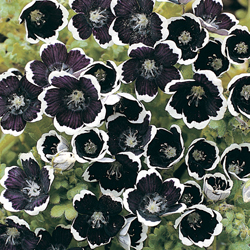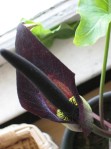 or Purple Tomatoes: Not Just for Heirlooms Anymore!
or Purple Tomatoes: Not Just for Heirlooms Anymore!
Purple tomatoes you say? What’s the big deal? The heirloom varieties such as ‘Black Prince’ and ‘Purple Cherokee’ have been tumbling across market stands and making their way to our tables for a number of years, delighting foodies and gardeners alike. So what on earth is all this horticultural hullabaloo about?
Meet the Indigo Rose.
This tomato doesn’t tumble or stumble. This baby waltzes.
The Indigo Rose, unlike the aforementioned varieties, is not an heirloom variety but more of a freak of nature–a carefully crafted freak, that is! It’s a fun new hybrid, and it has a very distinct difference from the other varieties. According to an article published by Oregon State University, whose horticulture department is responsible for the mad-creation of the ‘Indigo Rose’ variety, tomato fruits like ‘Black Prince’ and ‘Purple Cherokee’ get their color from various reactions within the tomato’s chemical makeup that results in a the green-skin gene producing a darker color.
In botanical-speak, OSU explains:
What causes the purple pigment?
A class of compounds generally called anthocyanin. The specific anthocyanins present in the tomatoes are mainly petunidin, but malvidin and delphinidin are also present. The anthocyanins are modified by the presence of acyl (sugar) groups. Anthocyanins are a member of a larger class of compounds called flavonoids. Other members of this class include quercetin, kaempferol, naringenin, catechin, and isoflavones. Phenols or Phenolics are related compounds that differ in basic chemical structure, but have similar function. In our tomato lines many different kinds of phenolics and flavonoids are up regulated along with the anthocyanins.
Say what?
Well, in a nutshell, the Indigo Rose has a purple-skinned gene rather than the typical green gene. This is the result of a high level of compounds known as anthocyanins, most commonly known as the compounds that give blueberries their nice, dark blue color.
Let’s face it, this is a true rotanical of the most Frankensteinian proportions. I’ve heard it doesn’t taste as good, falling short in flavor (but where it lacks in flavor, it makes up for in flavonoids)but as soon as I can sink my teeth into one, I’ll be the judge!
One other note that is important: this tomato has gotten a bad wrap already as being a GMO (genetically modified organism). It is not. It is a HYBRID. To quote again from the OSU article:
Were genetic engineering techniques used to develop these lines?
No, conventional crossing and selection techniques are being used. This is perhaps the most misunderstood aspect of this project, and we will say it again: These tomatoes are NOT GMO.
That means that they isolated naturally occurring genes from other plants and isolated them, combined them, and intensified them. Genetically modified organisms use new genes and sometimes new made-in-a-lab genes. This kind of isolating and breeding technique has been used for centuries, and in fact, many “heirloom” varieties are the result of hybridization. Just wanted to add a line in there in defense of this lil’ freak!
Check out the Territorial Seed Company’s online catalog description and see for yourself if you’d like to order some!





















